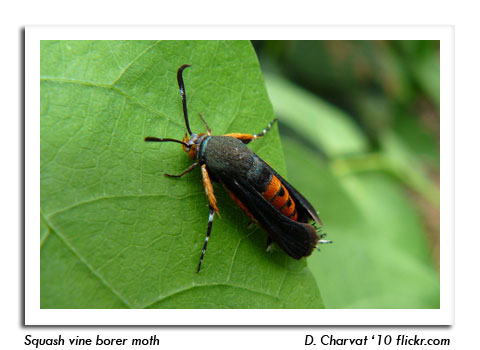
 |
|
|
Vegetables
Volume 57 Number 9 Date 06/07/2012 SQUASH VINE BORER - The adult emergence period is expected to begin shortly in the southern and central areas. Pumpkins, squash and other vine crops should be examined for eggs and evidence of feeding from 900-1,000 degree days (base 50°F). An organic control method which may be suitable for home gardens and small market gardens is syringe injection of the bacterial insecticide Bt (Bacillus thuringiensis) into each vine by hand. Conventional insecticidal controls are only effective if applied before the larvae bore into vines. LATE BLIGHT - Reports of late blight in Wisconsin have not been received to date, but commercial growers and home gardeners should be prepared take appropriate measures to protect their tomatoes and potatoes if conditions turn favorable for disease development. The accumulated disease severity value (DSV) for early-planted fields in the Hancock areas was 11 as of June 4, according to the latest UW-Extension Vegetable Crop Update. Fungicide applications for late blight control are advised once a DSV of 18 has been reached. VARIEGATED CUTWORM - Commercial potato growers have reported minor problems thus far, while home gardens in Dane County noted only light damage as of June 5. Larvae of this cutworm are expected to appear in greater numbers before month's end and regular monitoring of beans, potatoes and tomatoes is encouraged. If cutworm activity is suspected, plants should be visually inspected for larvae during the early morning hours. Treatment is recommended if 2-3% of developing fruits show feeding injury. Larvae in Dane County were approximately 1¼ inch long on June 6. COLORADO POTATO BEETLE - Overwintered adults continued to colonize potato fields in the Central Sands and northern production areas in the past week, signaling that oviposition has begun. Bacterial insecticide treatments of Bacillus thuringiensis var. tenebrionis (Btt) are most effective immediately after egg hatch and while the larvae are very small. The first of two foliar applications of Btt or an insect growth regulator should be made at egg hatch and again 7-14 days later. Most products must be reapplied 2-3 times to effectively control larval populations. --Clarissa Hammond, DATCP Pest Survey Program 




|
|
|